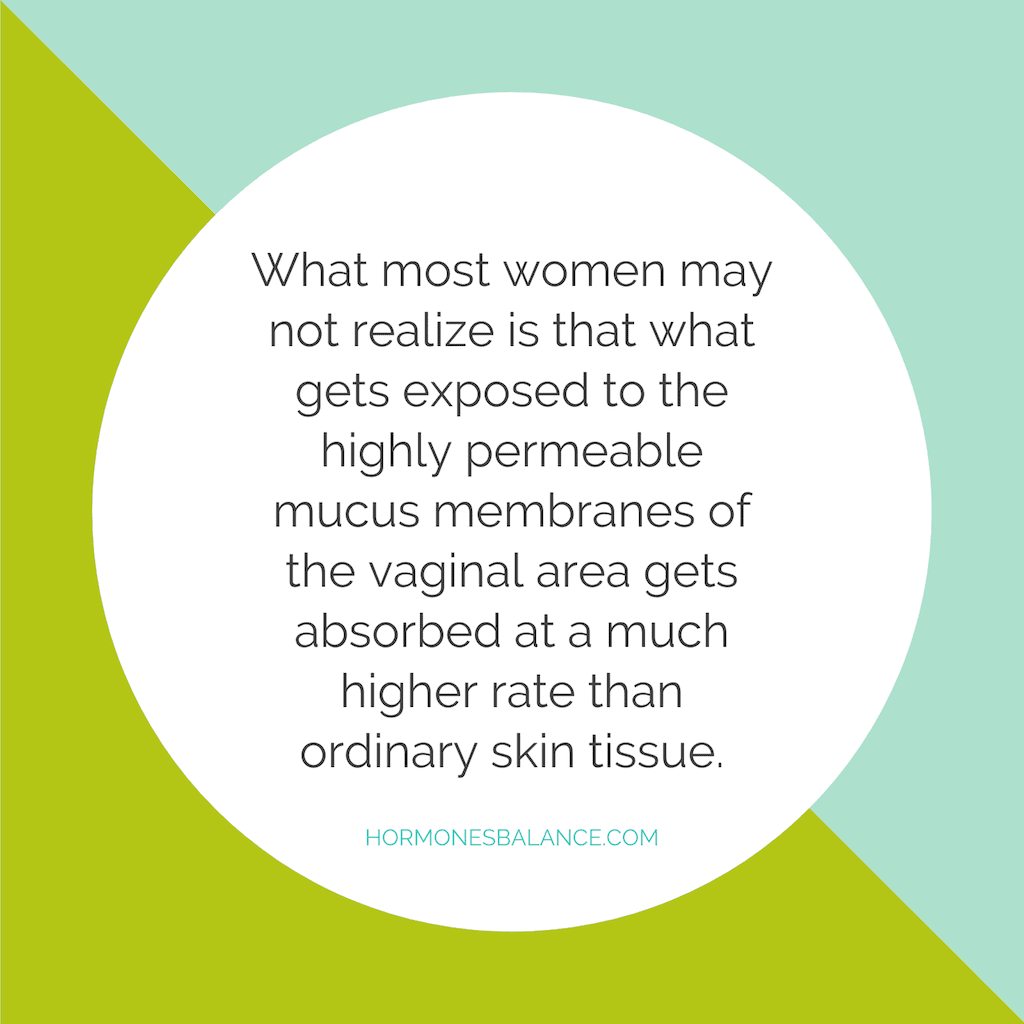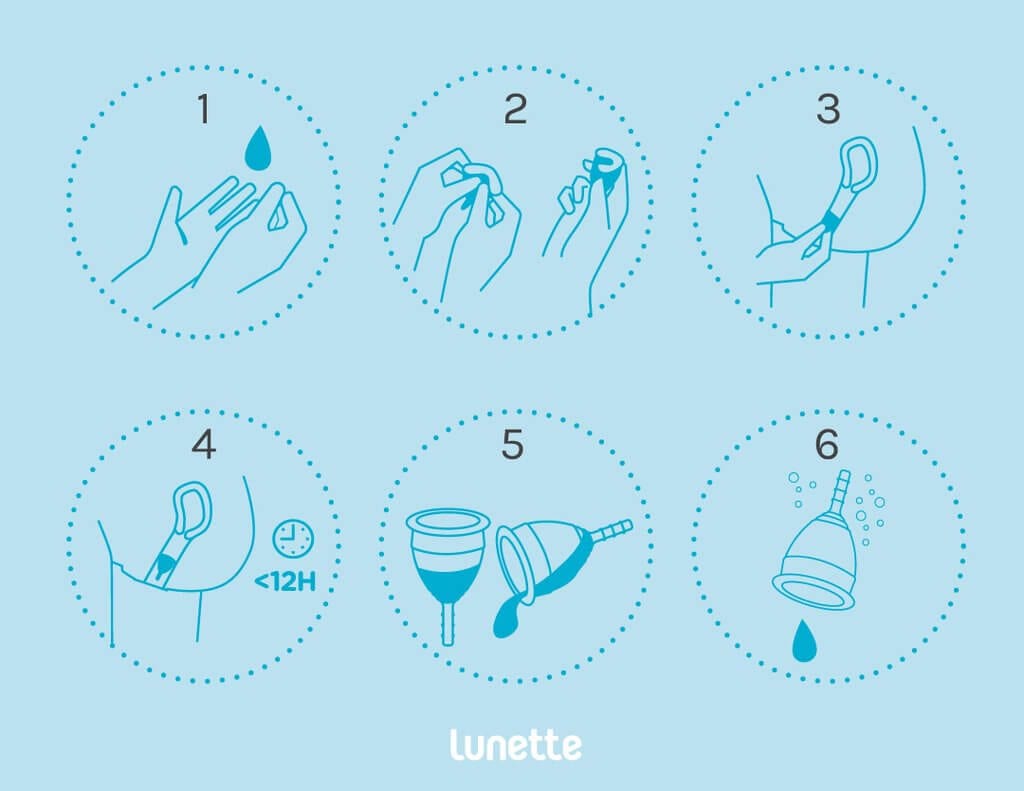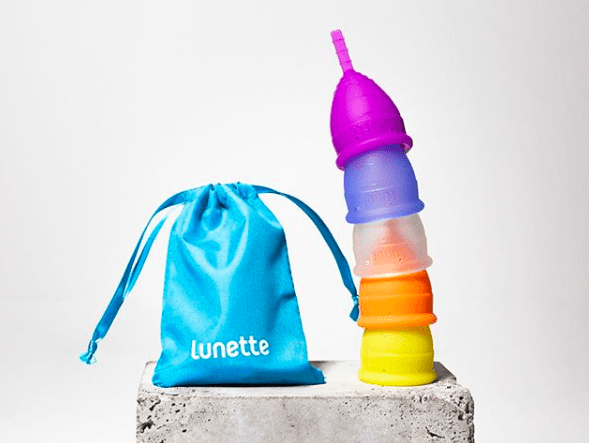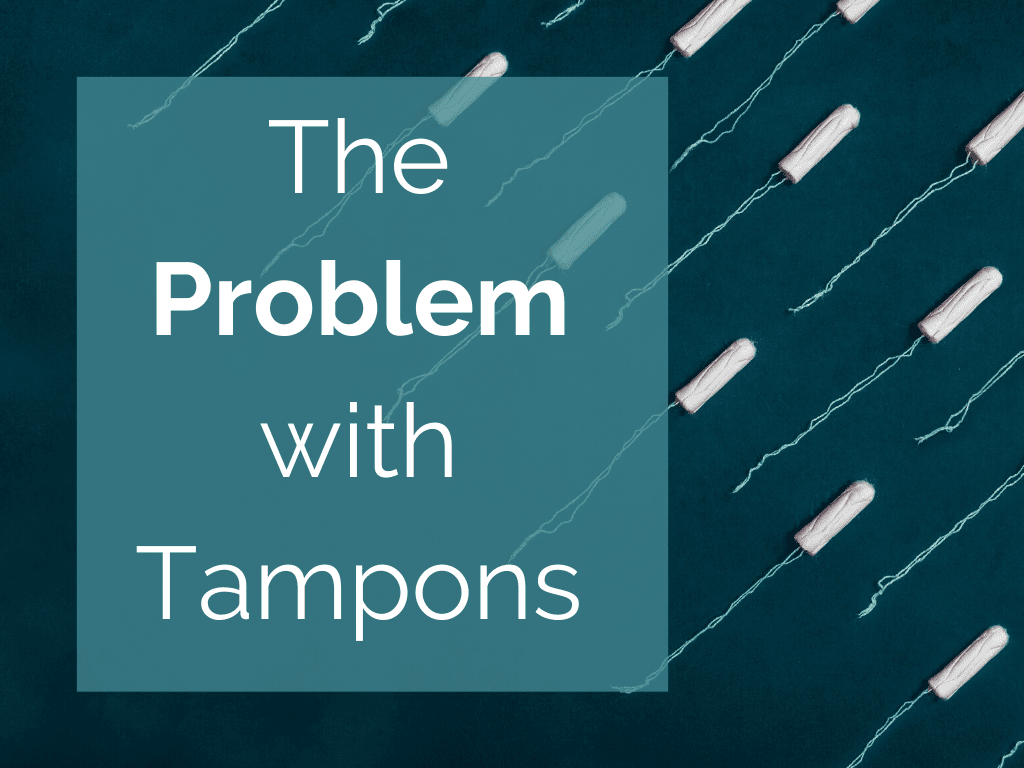What You Will Learn in This Article
- The Problem with Most Feminine Products
- Bleach and Hormone Disruptors Found in Feminine Products
- Healthier Alternatives
- Why Menstrual Cups Might be Better than Organic Tampons
- How to Use a Menstrual Cup
- What I Recommend
We already know it’s important to read the labels of our food, household cleaning products, and personal care products. We generally understand that what goes on our skin ends up in our bloodstream and can affect every area of our physiology, including our hormones. Organic whole foods, ✔check. Natural cleaning products, ✔check. Pure makeup and personal care products, ✔check.
What most women may not realize is that what gets exposed to the highly permeable mucus membranes of the vaginal area gets absorbed at a much higher rate than ordinary skin tissue. The vagina is considered a very effective way for getting drugs directly into the bloodstream without having to be metabolized first.
“[W]hen estrogenic drugs are administered vaginally, the resulting systemic levels of the drug in the body can be 10-80 times higher than when the very same dose is given orally.” (source)
That’s why it’s really important to know what’s in your feminine hygiene products.
The Problem with Feminine Products (Tampons, Pads, Etc.)
Feminine hygiene products, such as sanitary pads and tampons, are unfortunately not so pure and innocent as the pastel colors and flowery designs would lead you to believe. Modern feminine products are full of hazardous ingredients that have been linked to hormone disruption, allergic rashes, reproductive harm, and even cancer.
While many of these chemicals are also found in other personal care products such as lotions, perfume, nail polish, and makeup, they are extra harmful in feminine products because of their proximity to delicate tissues that are highly absorbant and permeable.
Helpful Tip: If you’re struggling with estrogen dominance and would like to learn more about how to balance your hormones, I invite you to join my Estrogen Reset program.
6 Problematic Compounds Found in Feminine Products
We know chemicals used in modern manufacturing processes and used in consumer products can contribute to estrogen dominance and even lead to early menopause. Here are some of the problematic and hormone-disrupting chemicals found in the vast majority of feminine hygiene products:
1. Bleach
Tampon fibers are often bleached, so they can alter the natural pH of the vagina. A healthy vagina should be acidic (pH ranges from 3.8 and 4.4). Mother Nature made it this way so pathogenic bacteria and yeast won’t survive in it. This is why tampons can contribute to vaginal yeast overgrowth.
Changes in vaginal pH can also affect the tissue integrity (or skin elasticity) of the vagina.
2. Dioxins and Furans
These chemicals can be found in traditional tampons and pads. They are contaminants left over from the bleaching process. These have been linked to endocrine disruption, reproductive harm, and cancer. Unfortunately, you’re not going to see these chemicals listed on the label. While the FDA recommends tampons be “…free of 2,3,7,8- tetrachlorodibenzo-p-dioxin(TCDD)/2,3,7,8-tetrachlorofuran dioxin (TCDF) and any pesticide and herbicide residues,” it isn’t mandatory. Tampons and pads fall under “medical equipment” and aren’t regulated in the same way as drugs or cosmetics. Medical devices aren’t required to disclose ingredients.
While testing has been done on dioxins and tampons, and levels were determined to be low, the study didn’t consider how permeable the tissues are “down there” and how levels of these toxins could end up being 10-80 times higher than if exposure had been through the diet.

3. Fragrance
This term, sometimes given in French (“parfum”), may disguise hundreds of chemicals, including hormone disruptors. In fact, “Fragrance” is often a cover-up name for phthalates – a very well documented family of chemicals causing a number of hormone imbalances, including thyroid problems.
Phthalates were dubbed “obesogens” in 2006 by Felix Grün and Bruce Blumberg of the University of California, Irvine who showed that they affect genes that influence the uptake of fat and grow fat cells.
Phthalates are xenoestrogens (external estrogen-mimicking compounds) that contribute to estrogen dominance and have also been linked to endometriosis, reduced sperm concentration and motility in men, plus, abnormal reproductive system development in baby boys.
A 2017 study found collected blood samples of pregnant women and found that as phthalate blood levels increased, leptin levels decreased. Leptin is a hormone that lets us know we are full, and decreased levels can result in overeating and ultimately, to weight gain and obesity.
Phthalates are only one potential concern. The International Fragrance Association’s (IFRA) list of chemicals that may be used in a “fragrance” also includes carcinogens like p-dichlorobenzene and styrene oxide and endocrine disruptors like galaxolide and tonalide.
4. Toluene & Xylene
These two petrochemical solvents were found sanitary pads tested in a March 2019 study. Xylene was detected in all 11 brands tested and toluene was found in nine. Researchers from The Endocrine Disruption Exchange (TEDX) and the University of Colorado, Boulder are concerned that these chemicals, even at low exposure, may cause hormone disruption.

5. Methyl Chloride
Methyl Chloride is another chemical found in the March 2019 study of menstrual pads. Methyl Chloride, or Dichloromethane, was found in two of the 11 brands of pads tested. This chemical is associated with endocrine disruption, reproductive harm, birth defects, and breast cancer. Not a great substance to have in a highly absorbable area.
6. Pesticide Residues
You’re not going to see these chemicals listed on the label either. The pesticide residues are left on the cotton after harvest. A 2015 study from the Socio-Environmental Interaction Space (EMISA) of the University of La Plata in Argentina found that feminine products, such as tampons and sanitary pads, were contaminated with glyphosate, the main ingredient in Monsanto’s herbicide, Roundup®.
According to Dr. Damian Marino of EMISA,
“85% of all samples tested positive for glyphosate and 62% for AMPA, which is the environmental metabolite, but in the case of cotton and sterile cotton gauze the figure was 100%.”
And, it turns out, AMPA (aminomethylphosphonic acid) may be even more toxic and persistent in our bodies than glyphosate.
Glyphosate has been found to be a hormone disruptor in peer-reviewed animal and cell studies. In fact, even at a dose of 0.5 parts per million (ppm), which is 800 times less than is allowed in animal feed, it was shown to cause hormone disruption.
This is why you want to make sure organic cotton is being used in your tampons.
Healthier Alternatives
Organic Tampons
Organic tampons differ from conventional ones in that they are made with organic cotton. These are a good option for avoiding harmful chemicals, fragrances, pesticide residues, and GMOs. The downside is that they can potentially leave behind fibers in the vaginal canal that could lead to Toxic Shock Syndrome (TSS) and must be changed every 4-8 hours. Buying organic also has its associated costs.
Organic Disposable Pads
Organic disposable pads are a good option if you don’t like to deal with tampons and the worry of fibers being left behind. The downside is that there’s a potential for leakage, there’s still a lot of waste, and again, the organic certification comes with a price tag.
Organic Reusable Cloth Pads
Organic reusable cloth pads, such as Glad Rags, are a good way to cut back on waste while using organic cotton. You can also save a lot of money as you aren’t buying new supplies each month. The downside is that it takes time to wash and dry them, they’re more bulky than some disposable pads, they can stain, and you have to bring used ones home with you if you change them while out.
Menstrual Cup
Menstrual cups are a great option for cutting back on waste and avoiding the potential for Toxic Shock Syndrome (TSS). They last for at least 3 years and can help you save on cash. What to watch for? Make sure they are free of latex if you’re allergic and plastics in general. Look for 100% medical grade silicone and make sure the brand is tested for chemical residues. Learn how to use them to have the best experience. If you have currently have fibroids, you may want to wait until the fibroids have shrunk before using a menstrual cup, just because you may find it doesn’t fit properly.
Tampons vs. Menstrual Cup

So, what’s the difference between menstrual cups and tampons? Why make the switch? If you’re already using organic tampons, you may wonder why you should consider switching to a menstrual cup. Here are a few reasons to switch:
Vaginal health. Keep your vagina free of bleach and hormone disruptors to prevent yeast infections and maintain good tissue elasticity.
Simplify. The menstrual cup only needs to be emptied 2-3 times per day. For most women, that’s just morning and evening.
Be more environmentally conscious. The average woman uses about 17,000 disposable period products in her lifetime… all of which end up in the landfill. One menstrual cup lasts about 3 years and can be burned without releasing harmful chemicals into the air.
Save money. Typical period products can cost an average of $60 to $84 per year. Or… you could buy one menstrual cup that lasts for 3 years.
No fibers left behind. Organic tampons are better than conventional ones, but they can still leave fibers behind, which can remain inside the vagina and cause irritation or even lead to Toxic Shock Syndrome (TSS).
No excessive absorption. If a tampon (even organic) is too absorbant, it can lead to tiny cuts in the vaginal tissue, which can also create an environment for TSS bacteria to enter the bloodstream.
No strings attached. No worries about someone seeing your string and no peeing on a string.
Potential for fewer cramps. Some menstrual cup users report fewer cramps compared to tampons. That may be due to tampons drying out the vagina or because they may contact with the sensitive cervix.
Never “run out.” Ever have to ask someone for a tampon or make a late night run to the store? Not with a menstrual cup. You’ll always be prepared.
If you’re experiencing symptoms estrogen dominance, you can find out more by taking my Free Estrogen Quiz. The truth is estrogen dominance symptoms occur to 75% of women, but a whopping 90% of them don’t even realize they have it. I recommend taking this quiz to find out for yourself here.
How to Use a Menstrual Cup

- Wash your hands and wash the menstrual cup.
- Fold the cup flat and then in half to form a C shape.
- Insert it, rim first, into the vagina. To make sure it’s opened properly, slide a clean finger up to the bottom of the cup and feel around it to make sure it’s round and not bent.
- Wear, emptying around 2-4 times per day. It can be used for up to 12 hours, including overnight.
- Remove & Empty. After washing hands, relax your muscles. Then, find the bottom of the cup and squeeze to release the seal. Pour contents into toilet, rinse in cold water, and reuse.
- Clean & Sanitize. Make sure to clean your menstrual cup before and after your cycle and after emptying.
How to Clean a Menstrual Cup
A lot of women might hesitate to try a menstrual cup because they think they must be difficult to clean. Not at all. Here’s how it’s done. Rinse the menstrual cup in cold water first and then follow by washing in hot water with a cleanser designed for it. Rinse again, and you’re done!
The Menstrual Cup I Recommend
Lunette is the menstrual cup I feel very confident in recommending.
Everyone has a different fit/comfort level and Lunette offers two different size options, depending on your flow, age, pregnancy experience, cervix, lifestyle, and bladder sensitivity.

It’s safe, easy to use, environmentally friendly, cost-effective, and a few more things, listed below…
Why Choose Lunette?

- Lunette helps you avoid harmful hormone-disrupting chemicals in conventional tampons and pads.
- Lunette is the only menstrual cup that has passed the rigorous Danish chemical safety test with zero chemical residue.
- Lunette Cup is made of medical grade silicone, which is material tested and approved by the FDA for biocompatibility with the human body.
- Lunette gives you the option of 6 fun colors to choose from.
- Lunette saves you money. Lunette Cups last for several years! Switching from tampons to a Lunette Cup could save you around $211 over 5 years. Switching from pads could save you around $400!
- Lunette helps you Go Green and keep menstrual waste out of the landfill. Lunette even has 100% plastic-free packaging.
- Lunette has safe cleansing products: Lunette’s Feelbetter Cup Cleanser is sulfite- and paraben-free and the cup wipes are made from biodegradable viscose.
- Lunette has great customer service with “Menstrual Mentors” on standby to answer all your questions.
Get Lunette here and start simplifying your cycle and save money at the same time.
Resources:
Bienkowski, Brian. Scientists Warn of Hormone Impacts from Common Solvents. Scientific American. April 15, 2015.
Burns, Carla and Rauhe, Kali. Study: Elevated Levels of Toxic Chemicals Found in Menstrual Pads and Disposable Diapers. Environmental Working Group. March 15, 2019.
ChemHAT. Dichloromethane (methylene chloride). Accessed January 25, 2020.
DeVito, Michael J, and Arnold Schecter. “Exposure assessment to dioxins from the use of tampons and diapers.” Environmental health perspectives. January, 2002.
Environmental Working Group. Dibutyl Phthalate. Accessed January 25, 2020.
Gasnier, Celine et al. Glyphosate-based herbicides are toxic and endocrine disruptors in human cell lines. Toxicology. August 21, 2009.
Grens, Kerry. Obesogens. The Scientist. November 1, 2015.
International Fragrance Association (IFRA). IFRA Survey: Transparency List. 2013.
Kim, Sung Hoon et al. Possible Role of Phthalate in the Pathogenesis of Endometriosis: In Vitro, Animal, and Human Data. The Journal of Clinical Endocrinology & Metabolism. December 1, 2015.
Mercola, Joseph. Women Beware: Most Feminine Hygiene Products Contain Toxic Ingredients. Huffington Post. June 17, 2013.
Meeker John D. and Ferguson, Kelly K. Relationship between urinary phthalate and bisphenol A concentrations and serum thyroid measures in U.S. adults and adolescents from the National Health and Nutrition Examination Survey (NHANES) 2007-2008. Environmental health perspectives. July 11, 2011.
Minatoya, M. et al. Association between prenatal bisphenol A and phthalate exposures and fetal metabolic related biomarkers: The Hokkaido study on Environment and Children’s Health. Environmental Research. February, 2018.
Nicole, Wendee. A question for women’s health: chemicals in feminine hygiene products and personal lubricants. Environmental health perspectives. March, 2014.
Park, Chan Jin et al. Sanitary pads and diapers contain higher phthalate contents than those in common commercial plastic products. Reproductive Toxicology. March, 2019.
Perro, Michelle. Glyphosate Overview. GMO Free USA. Accessed January 24, 2020.
Scranton, Alexandra. Chem Fatale: Potential Health Effects of Toxic Chemicals in Feminine Care Products. Women’s Voices for the Earth. November, 2013.
The Detox Project. Argentinian Study: Tampons, Sanitary Pads and Sterile Gauze Contaminated with Probable Carcinogen Glyphosate. October 21, 2015.
The Detox Project. Hormone Hacking. Accessed January 25, 2020.
U.S. Food & Drug Administration. Menstrual Tampons and Pads: Information for Premarket Notification Submissions (510(k)s) – Guidance for Industry and FDA Staff. July, 2005.
Title photo by Josefin.

I have tried menstrual cup and I cannot say that I liked it. First, to place it so that there are no leaks – I haven’t been able to. Secondly, in my case it had to be changed more often than the tampons. And thirdly, how to wash it delicately in the toilet?
Hey Maria!
Have you tried more than one brand of menstrual cups? Speaking from experience, not all cups are the same.
If you decide to give Lunette a try, you may want to consider trying the Model 2, for normal to heavy flow.
Finally, Lunette has a wonderful blog article “How To Use a Menstrual Cup” with helpful tips, like how to place cup to avoid leakage and how to wash it.
Hope this helps,
Taylor, HB Team
Silicone is a hormone disrupter. Just saying…